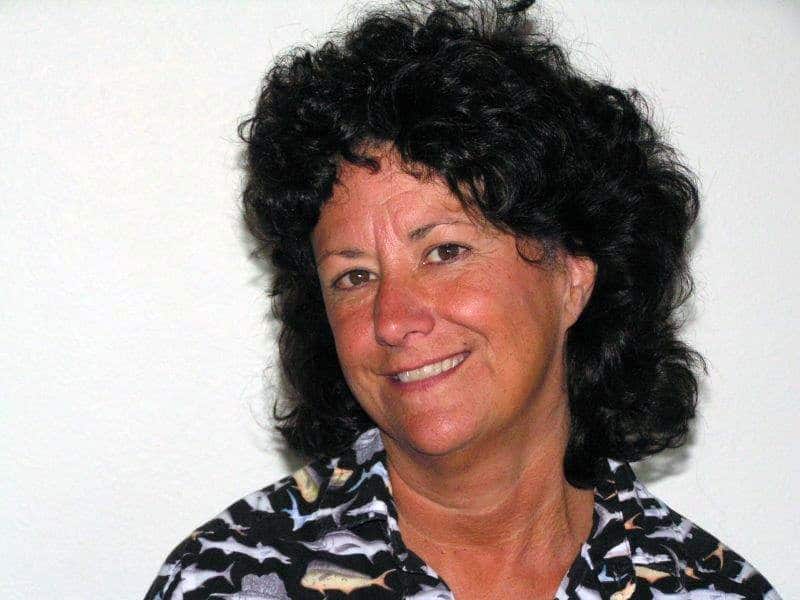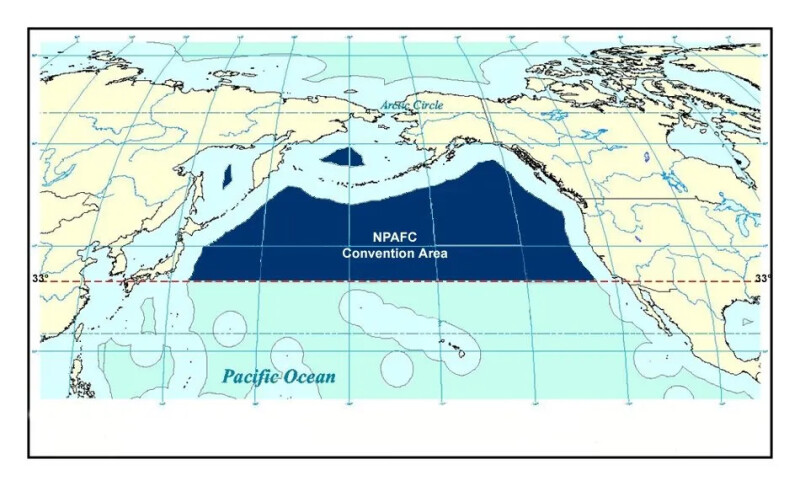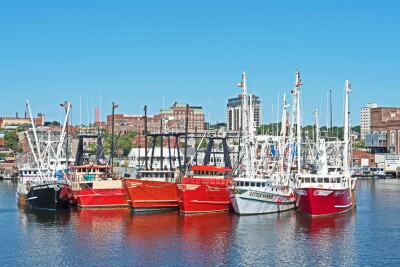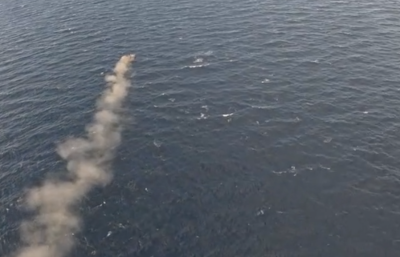As Alaska prepares for what could be one of its strongest salmon seasons ever, foreboding signs for the fishery's future are out on the water.
In 2024, commercial salmon catches declined throughout the North Pacific by more than 60 percent from the previous year, and the total weight of the salmon pack fell by over 50 percent.
The numbers were released last week by the North Pacific Anadromous Fish Commission (NPAFC) at its 32nd annual meeting in Vancouver, British Columbia. The catch totals are based on reports from its five member countries: Canada, Japan, South Korea, Russia, and the United States. The NPAFC promotes the conservation of salmon and steelhead trout in the North Pacific and its adjacent seas, and serves as a venue for the coordination of scientific research and enforcement activities.
By number, the combined North Pacific salmon harvest totaled 285 million fish, the lowest catch since 1988. The salmon weighed in at 528 thousand metric tons, or nearly 1.162 billion pounds.
Russia took home most of the North Pacific salmon in 2024 at 48 percent, or 251 thousand metric tons (over 552 million pounds). U.S. fishermen captured 42 percent of the salmon totaling 221 thousand metric tons (486.2 million pounds). Of that, 212 thousand metric tons (466.4 million pounds) were caught in Alaska.
Japan harvested roughly 9 percent of the total 2024 North Pacific salmon catch, with Canada accounting for 1 percent of the salmon and Korea for less than that.
Pink salmon constituted the majority of the total commercial catch by weight at 37 percent followed by chum at 35 percent, sockeye salmon at 24 percent, coho comprised 3 percent of the catch, while Chinook salmon, cherry salmon and steelhead trout were each less than 1 percent of the catch by weight.
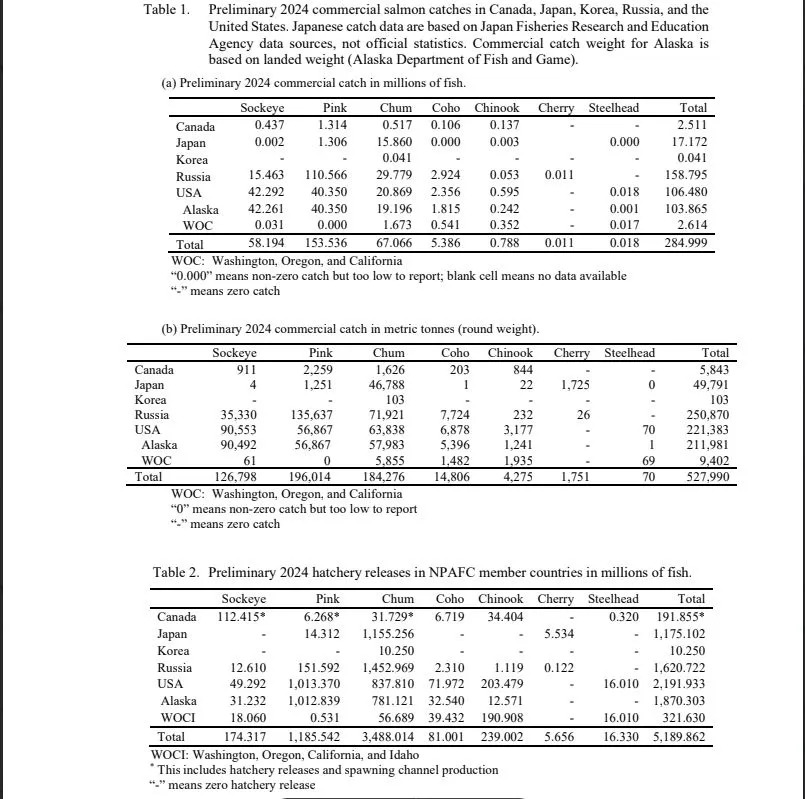
Big slumps for North American salmon
The total North American commercial salmon catch of 227,227 metric tons in 2024 (just under 500 million fish) was a decrease from 2023, which was expected given the odd/even year patterns in pink runs. However, it was the lowest pink salmon catch since 1976 in terms of weight.
The 2024 North Pacific sockeye catch of 91,464 metric tons (over 201 million pounds) was below the 10-year average of 134,942 metric tons (nearly 297 million pounds) and the first time it has been below 100,000 metric tons (220 million pounds) since 2013.
The catch of pink salmon was 59,127 metric tons in 2024 (just over 130 million pounds), the lowest since 1975 and 43 percent below the recent 5-year average for even years.
For chum salmon, the catch dropped 8 percent lower than 2023, after three years of increasing catches following a recent low in 2020.
Alaska, by far, provides most of North America's salmon catches, mostly sockeyes and pinks, followed by chum salmon.
The 2024 Alaska sockeye salmon catch was 90,492 metric tons (nearly 200 million pounds), which comprised about 99 percent of the sockeye catch taken in North America. The chum salmon catch in Alaska decreased by 17 percent compared to 2023 but was similar to the recent 10-year average of 74,411 metric tons (163.7 million pounds).
The Alaska 2024 pink salmon catch continued the odd/even year pattern of lower catches in even years and, at 56,867 metric tons (just over 125 million pounds), was the lowest catch since 1979.
Hatchery releases into the North Pacific top 5 billion fish
Hatchery releases of salmon and steelhead from NPAFC member countries have been stable since 1993, with approximately five billion fish released annually. About 67 percent of the combined hatchery releases were chum salmon, followed by pink salmon at 23 percent.
The U.S. leads all other nations in hatchery releases with 2.191 million fish (42.2 percent) in 2024, followed by Russia at 1.621 million releases (31.2 percent).
Hatchery releases were primarily chum (3,488 million, 67.2 percent) and pink (1,186 million, 22.8 percent), followed by Chinook (239 million, 4.6 percent), sockeye (174 million, 3.4 percent), coho salmon (81 million, 1.6 percent), steelhead trout (16 million, <1 percent), and cherry salmon (6 million, <1 percent).
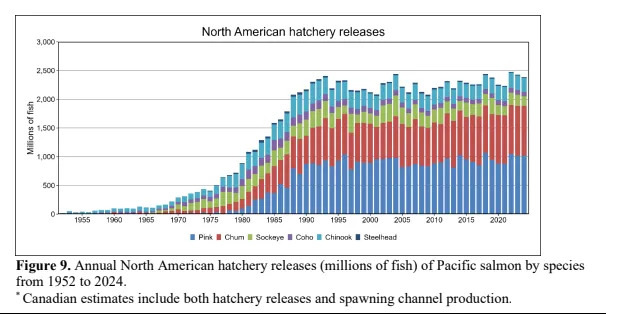
More salmon science this year
In 2025, NPAFC salmon research surveys are planned for the central, northeastern, and western Bering Sea, the western and central North Pacific, and the Sea of Okhotsk. Researchers will examine conditions such as migration timing, abundance, distribution, survival, stock assessment, and marine conditions.
The 2026 NPAFC Annual Meeting will be held again in Vancouver, British Columbia.




